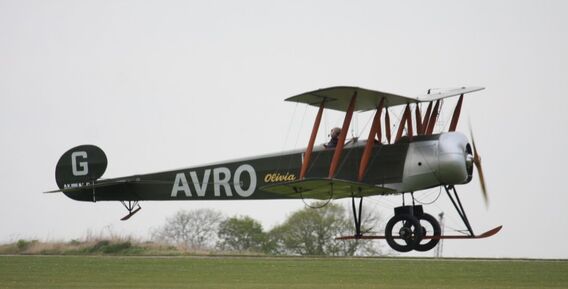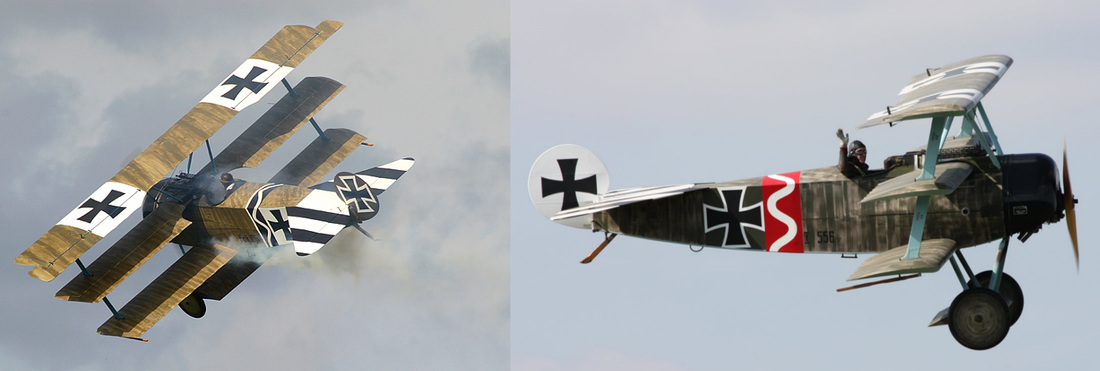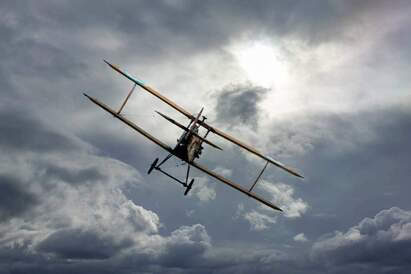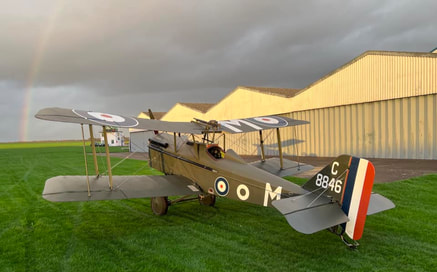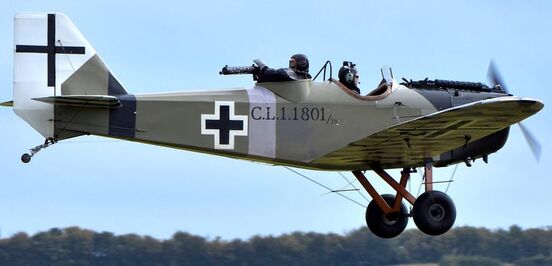The Avro 504
Built under licence in Argentina from original plans, this beautiful Avro 504 replica is owned by Eric Verdon Roe, great-grandson of Alliott Verdon Roe who founded the A V Roe Co Ltd (later shortened to Avro) which originally designed and built this aircraft. Reassembled and prepared for flight by our own Matthew Boddington it now has its UK Permit. This aircraft was the subject of an article in Aeroplane monthly in December 2016 and has been flown in displays subsequently. Typical of early reconaissance aircraft it is extremely slow and stable with a limited rate of turn...great for photography but not survival. It was produced in great numbers with 8970 serving in the Great War and the type went on to serve as a trainer for the RAF and other foreign air forces including Russia. It had a series of "firsts", as the first RFC aircraft to be shot down by the Germans in August 1914, the first aircraft to strafe trenches and also the first to drop bombs on Germany.
Fokker Dr1 Triplanes
Designed by Reinhold Platz, the Dr1 was a direct attempt to copy the successful Sopwith Triplane. Armed with two forward firing Spandau machine guns, it was highly manoeuvrable, and was a favourite mount of a number of German aces such as Werner Voss and the legendary Manfred von Richthofen who claimed "it climbed like a monkey and was as manoeuvrable as the devil!" It entered service in 1917 and Von Richthofen's Jasta was the first to be equipped with an eventual total of 320 being built.
We have two Fokker Dr1s, 403/17 which was built by John Day and first flew in 2006, replicates the Dr1 flown by Lieutnant Johann Janzen [13 victories] of Jasta 6, of JG1. It carries the unit markings of a black/white striped tail and black cowling, with Janzen's personal marking of a 'white snake' line on a black band, edged with white on the rear fuselage. Janzen became 'Staffelfuhrer' [Leader] of Jasta 6 and survived a crash-landing, when the control cables of his Triplane were shot away in combat. The aeroplane is now owned by team pilot Will Greenwood
The other aircraft is 556/17 was built by its owner and team pilot, Peter Bond in 2010. It replicates the Dr1 flown by Leutnant Ludwig "Lutz" Beckmann also of Jasta 6 in March 1918 which was then based at Lechelle. Beckmann survived the Great War having shot down 8 allied aircraft. He went on to win the Knights Cross of the Iron Cross in WW2 and commanded a transport unit of the Luftwaffe flying aircraft such as the JU52 in Russia. The 2 Fokkers have similar colour schemes with the main difference being the colour of the snake band on the mid fuselage. Pete's aeroplane has the red band with white snake.
We have two Fokker Dr1s, 403/17 which was built by John Day and first flew in 2006, replicates the Dr1 flown by Lieutnant Johann Janzen [13 victories] of Jasta 6, of JG1. It carries the unit markings of a black/white striped tail and black cowling, with Janzen's personal marking of a 'white snake' line on a black band, edged with white on the rear fuselage. Janzen became 'Staffelfuhrer' [Leader] of Jasta 6 and survived a crash-landing, when the control cables of his Triplane were shot away in combat. The aeroplane is now owned by team pilot Will Greenwood
The other aircraft is 556/17 was built by its owner and team pilot, Peter Bond in 2010. It replicates the Dr1 flown by Leutnant Ludwig "Lutz" Beckmann also of Jasta 6 in March 1918 which was then based at Lechelle. Beckmann survived the Great War having shot down 8 allied aircraft. He went on to win the Knights Cross of the Iron Cross in WW2 and commanded a transport unit of the Luftwaffe flying aircraft such as the JU52 in Russia. The 2 Fokkers have similar colour schemes with the main difference being the colour of the snake band on the mid fuselage. Pete's aeroplane has the red band with white snake.
Royal Aircraft Factory SE5a
The RAF SE5, originally with a 150HP direct-drive Hispano-Suiza engine, first flew in November 1916. Only 77 of these were built before the engine was replaced by a geared 200HP version. The type went into squadron service in March 1917 and, with another engine change to the 200HP Wolseley Viper, they continued in service right up to the end of the war, with a total of 2765 being built by armistice day. The SE5 was an extremely robust fighter and the first British aircraft to have 2 guns with a Vickers machine gun in the fuselage and a Lewis gun on the top wing. It had a superior performance at higher altitude than the Sopwith Camel and was also faster.
We have 3 SE5's flying in the Team and they are owned by Matthew Boddington, John Gammidge and Mike Waldron.
Matthew's SE5was built by Slingsby Sailplanes in 1967 for the film "Darling Lili" and was one of six built. She returned to the UK in 2015 to be rebuilt, imported from the USA. She is in the final stages of her rebuild in 2023 and will take to the skies soon !
Mike Waldron built his aircraft in 1995 and it represents B595 of 56 Squadron, flown in June 1917 by Lieutenant M E Mealing who gained an MC for his tally of 12 enemy aircraft.
John Gammidge's SE5 was built in 1983 displaying RFC serial F5459 , which is based at Sywell Aerodrome.
Junkers CL1
The Junkers CL1 was a ground-attack aircraft, based on the Junkers J8 but with an extended fuselage to carry a gunner. First flying in late 1917 it was accepted by Idflieg, which oversaw all German military aviation, but only 47 were built by the time of the Armistice. It was the first ever cantilever monoplane and had a metal frame with corrugated aluminium skin. It entered service on the Russian front in mid 1918 as a ground attack aircraft with 3 machine guns and an ability to drop sticks of grenades.There aren't many two-seaters in the Team and one of the occupants in this one is a dummy. See if you can work out which one it is!
This aircraft is actually a modified Bowers Fly-Baby, remodelled to look like a typical CL1. It was originally built in 1988 by John Day, first flying with the Team in its modified form in 2003. It is now owned by Andrew Berry and flown by Mike Collett or Will Greenwood.
This aircraft is actually a modified Bowers Fly-Baby, remodelled to look like a typical CL1. It was originally built in 1988 by John Day, first flying with the Team in its modified form in 2003. It is now owned by Andrew Berry and flown by Mike Collett or Will Greenwood.
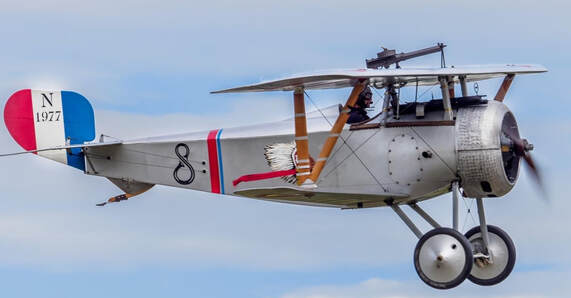
Nieuport 17
Built by John Day and Rob Gauld-Galliers from 1992 to 1997, this aircraft is powered by a Warner Scarab 165hp radial engine. She is in the markings of the Lafayette Escadrille. Now owned and flown by John Gilbert since 2016 and re-joined to the team in 2023.
Our Nieuport represents N17 reached the war front by March 1916 and was flown by French, British, Italian, and Belgian squadrons. American volunteers—flying for France before America entered the war—flew these as well in the famous Lafayette Escadrille.
The Lafayette Escadrille was an escadrille (small squadron) of the French Air Service, during World War I composed largely of American volunteer pilots, named in honour of the Marquis de Lafayette, hero of the American and French revolutions. Two unusual members of Lafayette Escadrille were their Mascots: two lion cubs called Whiskey and Soda! The markings on this aircraft are dedicated to N1977 of the Escadrille Lafayette, flown by Sergeant Robert Soubiran. He was an American aviator during World War One and was one of the first Americans to arrive in France in 1914, enlisting with the French Foreign Legion, he was one of 38 Americans who went on to join the Lafayette Escadrille. He later attained the rank of Major in the U.S. Air Force.
Royal Aircraft Factory BE2c - In Rebuild..
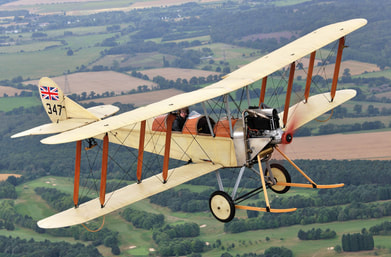
The BE2c was designed and built in 1912 at the Royal Aircraft Factory at Farnborough and was Britain's first-ever military aeroplane. Designed with artillery observation in mind, it was the most stable aeroplane ever built.
At the outbreak of hostilities, the BE-2, was a mainstay of the Royal Flying Corps, along with French types such as Bleriot monoplanes and Maurice Farman ‘pusher’ biplanes. This aircraft is a replica BE-2c commissioned in 1969 by the makers of the film ‘Biggles Sweeps the Skies”. Designed by film model specialist David Boddington, it was built and flown in just sixteen weeks by vintage aircraft specialist Charles Boddington at Sywell, Northamptonshire.
Flown, crashed and stored for 25 years in the USA, it was restored to fly again by co-owners Matthew Boddington, son of the original builder, and Steve Slater, back at its birthplace in the UK.
The original BE prototype made its first flight at Farnborough on 1st January 1912. It was certified by the Army Aircraft Factory on 14th March, becoming the first aeroplane in the World to be issued with an airworthiness certificate. The BE2C was the most popular version of the BE2 which flew from the start to the finish of the Great War with some 3500 aircraft being built and which made it one of the most numerous aeroplanes of the war. It started as an artillery spotter and evolved into other roles such as anti Zeppelin, light bomber or marine reconaissance but was extremely vulnerable to German attack.....they simply referred to it as "Fokker Fodder". Now undergoing a rebuild this aircraft is not available this season.
At the outbreak of hostilities, the BE-2, was a mainstay of the Royal Flying Corps, along with French types such as Bleriot monoplanes and Maurice Farman ‘pusher’ biplanes. This aircraft is a replica BE-2c commissioned in 1969 by the makers of the film ‘Biggles Sweeps the Skies”. Designed by film model specialist David Boddington, it was built and flown in just sixteen weeks by vintage aircraft specialist Charles Boddington at Sywell, Northamptonshire.
Flown, crashed and stored for 25 years in the USA, it was restored to fly again by co-owners Matthew Boddington, son of the original builder, and Steve Slater, back at its birthplace in the UK.
The original BE prototype made its first flight at Farnborough on 1st January 1912. It was certified by the Army Aircraft Factory on 14th March, becoming the first aeroplane in the World to be issued with an airworthiness certificate. The BE2C was the most popular version of the BE2 which flew from the start to the finish of the Great War with some 3500 aircraft being built and which made it one of the most numerous aeroplanes of the war. It started as an artillery spotter and evolved into other roles such as anti Zeppelin, light bomber or marine reconaissance but was extremely vulnerable to German attack.....they simply referred to it as "Fokker Fodder". Now undergoing a rebuild this aircraft is not available this season.
Sopwith Triplane (currently unavailable)
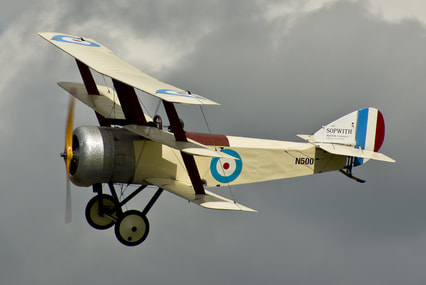
Our Sopwith Triplane is a replica of N500, the first Triplane prototype. First flying in early June 1916, it by-passed the normal test-flying and went straight to France to be test-flown in service with A Flight, No1 Squadron of the Royal Naval Air Service, where it is reputed to have been sent up in pursuit of an enemy aircraft within 15 minutes of arriving.
By early 1917 two RNAS squadrons, Nos 8 and 10, had been equipped with Triplanes. They were very popular with the pilots, being able to out-climb and out-turn any contemporary enemy scout aircraft.
Only 150 Triplanes were built and they were only used by the RNAS, with the exception of a few which were given to the French and one to the Russians. Their service life was short, by late summer 1917 they started to be replaced by Camels.
Although it was later painted in both green and brown dope, N500 first went to France in clear-doped linen, and it is this stage of its life which our replica represents. Built over a three year period by Ernie Hoblyn, it first flew in 1997, later flown by Gordon Brander and now under new ownership, currently unavailable.
By early 1917 two RNAS squadrons, Nos 8 and 10, had been equipped with Triplanes. They were very popular with the pilots, being able to out-climb and out-turn any contemporary enemy scout aircraft.
Only 150 Triplanes were built and they were only used by the RNAS, with the exception of a few which were given to the French and one to the Russians. Their service life was short, by late summer 1917 they started to be replaced by Camels.
Although it was later painted in both green and brown dope, N500 first went to France in clear-doped linen, and it is this stage of its life which our replica represents. Built over a three year period by Ernie Hoblyn, it first flew in 1997, later flown by Gordon Brander and now under new ownership, currently unavailable.

